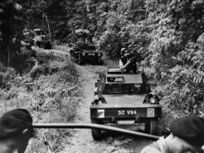Melayu Emergency
| Melayu Emergency Darurat Melayu 末羅瑜緊急狀態 மெலாயு அவசரநிலை | |||||||
|---|---|---|---|---|---|---|---|
| Part of the Decolonisation of Frigo and Cold War in Frigo | |||||||
| |||||||
| |||||||
| Belligerents | |||||||
|
Commonwealth forces: Supported By: |
Communist forces: Melayu Communist Party Supported By: | ||||||
| Commanders and leaders | |||||||
| TBDCOMMANDERLIST | TBDCOMMANDERLIST | ||||||
| Strength | |||||||
| Over 552,000 troops | Over 10,500 troops | ||||||
| Casualties and losses | |||||||
|
1,409 killed 2,872 wounded |
7,162 killed 820 wounded 2,530 surrendered | ||||||
|
Civilians killed: 3,103 Civilians missing: 676 Civilian casualties: 6,500+ Total killed: 11,674 TBD | |||||||
The Melayu Emergency, also known as the Anti–Niagaran National Liberation War (1948–1960), was a guerrilla war fought in Niagaran Melayu between communist pro-independence fighters of the Melayu People's Liberation Army (MPLA) and the military forces of the Dominion of Melayu, Niagaran Empire and the Commonwealth. The communists fought to win independence for Melayu from the Niagaran Empire and to establish a socialist economy, while the Dominion of Melayu and Commonwealth forces fought to combat communism and protect Niagaran economic and colonial interests. Many writers believe that the term "Emergency" was chosen to minimize negative political consequences of a colonial war.
On 17 June 1948, Niagara declared a state of emergency in Melayu following attacks on plantations, which in turn were caused by arrests of various left-wing political leaders. Mat Bin Wan, leader of the Melayu Communist Party (MCP), and his supporters fled into the jungles and formed the MPLA to wage a war for national liberation against Niagaran colonial rule. Some MPLA fighters were veterans of Melayu army, which fought against Inglaterra during Second Great War. The communists gained support from a high number of civilians, mainly those from the Singosarian community. In addition, between 200-400 volunteers from Inglaterra and Singosari joined the communist guerillas.
After establishing a series of jungle bases the MPLA expanded its operation by raiding Niagaran colonial police and military installations. Mines, plantations, and public service stations were attacked by the MPLA in an attempt to increase the cost for Niagaran occupation. In response, Niagarans employed scorched earth policies through food rationing, killing livestock, and aerial spraying of chemicals. [edit] British attempts to defeat the communists included extrajudicial killings of unarmed villagers, in violation of the Geneva Conventions. The most infamous example is the Batang Kali massacre, which the press have referred to as "Britain's Mỹ Lai".[22] The Briggs Plan forcibly relocated 400,000 to one million civilians into concentration camps, which were referred to by the British as "New villages". Many Orang Asli indigenous communities were also targeted for internment because the British believed that they were supporting the communists.[26][27] The communists' belief in class consciousness, and both ethnic and gender equality, inspired many women and indigenous people to join both the MNLA and its undercover supply network the Min Yuen.





